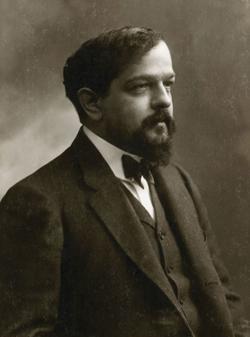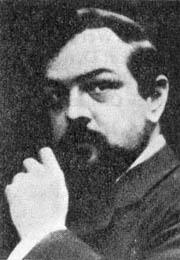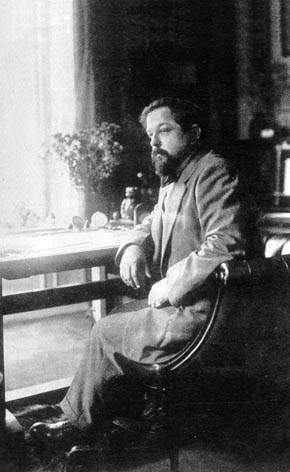Composer (MIDI)
Achille Claude Debussy (1862-1918); FRA
 Loading, please wait...
Loading, please wait...
Achille-Claude Debussy was perhaps the most original musical mind at the turn of the century. While Schoënberg's serial innovations were essentially a search to replace what he considered the used up resources of tonality in order to save the great German tradition, Debussy's quiet revolution was a deeper one that questioned the very essence of western forms and thematic organization. In Debussy we have the first true elevation of sound, color, and even silence to primary compositional status. In this, he was a profound influence on composers as diverse as Bartok, Webern, and Varese. As Stravinsky stated, "The musicians of my generation and I myself, owe the most to Debussy."
Debussy is inextricably tied in the public mind with Impressionism, but like many of the painters, he disliked the term and would be more accurately described as a Symbolist. He was more drawn to the atmospheric canvasses of Turner and Whistler than those of Monet and his circle, and in literature his affinities were Mallarmé, Rimbaud, Verlaine and Edgar Allen Poe.
Nonetheless, some analogies to artistic impressionism have validity. In their desire to render the delicate sensation of the particularities of weather and the specific time of day, the impressionist painters used light, feathery brush strokes that often blurred the outlines of objects. Debussy loved chords such as the ninth that make ambiguous the traditional functionality of the root harmony so that the chords float with no obvious direction. Thus the clear outlines of harmony and harmonic progression are muted and softened. And in the same way the impressionist painters tried to capture the essence of a fleeting moment or mood, so did Debussy, in music that is most often suggestively titled, but in no way interested in programmatic story telling.
 The impressionist and post impressionist painters were highly influenced by eastern art, particularly the flat color fields and abrupt angles and croppings of Japanese prints. The flattening of traditional perspective may be likened to Debussy's much looser use of tonality. In traditional Western practice, the gravitational pull of the tonic acts as the horizon line that organizes and prioritizes all the elements in a painting. Much as the painters did, Debussy used traditional elements such as triads, but juxtaposed them in ways that negated their traditional functions. They serve more as independent colors and are liberated from their subservience to chord progressions.
The impressionist and post impressionist painters were highly influenced by eastern art, particularly the flat color fields and abrupt angles and croppings of Japanese prints. The flattening of traditional perspective may be likened to Debussy's much looser use of tonality. In traditional Western practice, the gravitational pull of the tonic acts as the horizon line that organizes and prioritizes all the elements in a painting. Much as the painters did, Debussy used traditional elements such as triads, but juxtaposed them in ways that negated their traditional functions. They serve more as independent colors and are liberated from their subservience to chord progressions.
In his desire to move beyond the all pervasive Wagnerisms of the day, Debussy used a new vocabulary including whole tone, modal, and pentatonic scales that were in part influenced by his exposure to the Balinese gamelan orchestra that he heard at the World Exposition in 1889. Debussy found sonata procedures and German linear thinking meaningless to him. There is in mature Debussy less a reliance on thematic logic than on intuitive associations and connections. He wrote in 1902, "I wanted from music a freedom which it possesses perhaps to a greater degree than any other art, not being tied to a more or less exact reproduction of Nature but to the mysterious correspondences between Nature and Imagination."
Debussy was born on August 22, 1862, at St. Germain-en-Laye, on the outskirts of Paris; at the time his parents were running a china shop. His father was later imprisoned for revolutionary activities in 1871 during the Commune. Debussy was meanwhile receiving piano lessons from Mme. Maute, the mother-in law of Verlaine. In 1872 he was accepted in the piano and theory classes at the Paris Conservatoire. At one point he had studies with Franck, whom he derisively referred to as a "modulating machine."
Although a promising pianist, Debussy failed to win awards at the piano competitions of 1878 and 79 and turned fully to composition studies. By 1883, he had won the second Prix de Rome and the following year he won the first Prix with his cantata "L'enfant prodigue." Debussy had already been to Italy as a pianist in the trio of Mme. Nadja von Meck (Tchaikovsky's patron), but his stay at the Villa Medici in Rome was anathema to him and he left as soon as the minimum two years were up without writing the customary overture associated with his prize.
Debussy was described by his associates as a difficult and reserved man, with an independence that bordered on disdain for convention. From about this time, he began a liaison with Gabrielle Dupont (profession unknown) with whom he lived in near poverty for the next nine years.
In 1892, Debussy became friendly with composer, Ernest Chausson after writing "Fêtes Galantes" on poems by Verlaine. He began the epochal "Prelude a l'après-midi d'un faune" and a first version of the "Nocturnes," but it was the April 1893 performance of "La damoiselle élue" that first brought him public attention. The next month he attended Maeterlinck's "Pelléas et Mélisande" and at once began to sketch an opera. In December of the same year, the Ysaye Quartet gave the first performance of the the "String Quartet in g." The Prélude à l'aprèsmidi d'un faune was performed in December 1894. The languid and sexually suggestive solo flute that opens the piece traversing a tonally ambiguous tritone, begins the twentieth century for many musicians. A comparison of this solo with the solo bassoon opening of Stravinsky's "Rite of Spring" is provocative.
In 1897, Gabrielle attempted suicide and thus began a difficult period in Debussy's life. In October 1899, Debussy married Rosalie Texier, a model and friend of Dupont. In December the "Nocturnes" for orchestra (2.Fêtes) were completed. During the rehearsal of the now completed "Pelleas and Melisande" in April 1902, Debussy was being prosecuted for non-payment of debts. The opera was quickly recognized as a landmark in French music.
 The next years were particularly productive. Works of 1904-5 include "La Mer" for orchestra (1.De l'aube à midi sur la mer) and the first set of "Images" for piano. The new confidence in his work has been ascribed by some to a change in Debussy's domestic life. In the autumn of 1903, he met Emma Bardac, the wife of a banker and an amateur singer (11 years earlier, Fauré had dedicated a song cycle to her). In June, Debussy left his wife and in autumn moved with Bardac into an apartment rented with her money. In October, his wife attempted suicide and a number of Debussy's friends broke off relations with him in disgust. In October 1905 a daughter nicknamed Chou-Chou was born to the new couple. They married in January 1908.
The next years were particularly productive. Works of 1904-5 include "La Mer" for orchestra (1.De l'aube à midi sur la mer) and the first set of "Images" for piano. The new confidence in his work has been ascribed by some to a change in Debussy's domestic life. In the autumn of 1903, he met Emma Bardac, the wife of a banker and an amateur singer (11 years earlier, Fauré had dedicated a song cycle to her). In June, Debussy left his wife and in autumn moved with Bardac into an apartment rented with her money. In October, his wife attempted suicide and a number of Debussy's friends broke off relations with him in disgust. In October 1905 a daughter nicknamed Chou-Chou was born to the new couple. They married in January 1908.
After Bardac's financier uncle disinherited her, Debussy's hopes of prosperity were dashed. For the next seven years he had to make ten trips abroad, conducting his own works and playing the piano, neither of which activity was pleasurable for him. In 1909, he was appointed to the board of the Paris Conservatoire and began his first book of "Preludes" (8.La fille aux cheveux de lin) for the piano. He also had the first signs of the rectal cancer that would eventually kill him.
In 1915, Debussy was commissioned to produce an edition of Chopin. This labor of love inspired the 12 "Etudes" for piano and is symbolic in that Debussy's piano music is the first since Chopin to truly explore new sounds and approaches to the instrument. Taking Chopin's style a step further, he insisted that the piano should sound as though it were "an instrument without hammers."
Debussy's last works were three sonatas that were to be part of a cycle of six, and perhaps a new reconciliation with classical forms. He completed the "Sonata for Cello and Piano (1.Prologue; 2.Serenade & 3.Finale)," "Sonata for Violin," and the "Sonata for Flute, Viola and Harp" by May 1917, when he gave his last performance playing in the violin sonata. After a colostomy in December, he was confined to bed. Debussy died March 25, 1918.
Debussy referred to himself as a "musicien francais" and he is certainly one of the greatest of all French composers. In his sensuous love of sound and in his ability to capture the poetic essence of an idea, mood or scene (i.e. The Snow is Dancing, from "A Children's Corner," Fireworks, from the second book of "Preludes," or Nuages from "Nocturnes," etc.), Debussy reinvents and continues the great French tradition of Couperin and Rameau into the twentieth century at the time when Paris was the center of all art.
Biography by Allen Krantz. Copyright © Classical Archives, LLC. All rights reserved.
###
Debussy, Achille-Claude (b St Germain-en-Laye, 1862; d Paris, 1918). Fr. composer and critic. As a child he had little formal education but his mus. tendencies were channelled into pf. lessons, those with Verlaine's mother-in-law, Mme Mauté de Fleurville, leading to his entry into the Paris Cons. in 1872. His reputation there was that of an erratic pianist and a recalcitrant in matters of harmony and theory. In 1880 and 1881 he went for summer employment to Russia as pianist to Tchaikovsky's patron, Mme von Meck. Failing to win the Prix de Rome in 1883, he succeeded in 1884 with the cantata L'Enfant prodigue. He spent 2 years at the Villa Medici, Rome, where he met Liszt, Verdi, and Boito, and heard Lohengrin. He went to the Bayreuth fests. of 1888 and 1889, but an even greater mus. influence was that of hearing the Javanese gamelan at the 1889 Paris Exposition. Other influences of these years were his friendship with the painters of what became known as the ‘Impressionist’ movt. and, even more important, with writers and poets such as Mallarmé and the ‘symbolists’. But after 1889 he could not share the symbolists' idolatry of Wagner, recognizing his greatness but also the fact that he represented a ‘dead end’ for other composers. He cultivated a distinctively Fr. mus. outlook, eventually styling himself ‘musicien français’. Other significant events in his life were his study in 1889 of the score of Boris Godunov and his acquaintance from 1891 with Erik Satie.
In 1893 Debussy began work on an opera based on Maeterlinck's play Pelléas et Mélisande, a task that was to occupy him for nearly 10 years. In 1893 his str. qt. was perf., and in 1894 his orch. Prélude à l'Après-midi d'un Faune upset certain critics with its alleged ‘formlessness’. He followed this with his 3 Nocturnes, orig. planned for solo vn. and orch., perf. 1900 and 1901. They are ded. to Rosalie (Lily) Texier, whom he married in 1899 but deserted 5 years later for Mme Emma Bardac, a singer and wife of a banker, whom he married in 1908. Their child was born in 1905, the year in which the symphonic sketches La Mer were f.p. Pelléas had been successfully prod. at the Opéra-Comique in 1902, to the fury of Maeterlinck who publicly wished it ‘emphatic failure’. Debussy's remaining orch. works were the set of 3 Images comp. between 1905 and 1912, and the ballet Jeux for Diaghilev (1913). In 1910 he developed cancer and was a semi-invalid when war broke out in 1914. He wrote some mus. inspired by patriotic sentiments and completed 3 sonatas before his death. He wrote mus. criticism under the pseudonym of M. Croche. A collection, Monsieur Croche antidilettante, was pubd. in Paris 1921 (Eng. trans. 1962).
Debussy was among the greatest and most important of 20th-cent. composers both by reason of his own achievement and by the paths he opened for others to explore, hence the homage to him paid by later composers such as Boulez, Messiaen, Webern, Bartók, Stravinsky, and many others. His use of block chords, of harmony with a modal flavour and based on the whole-tone scale, the delicate colours of his orchestration, his technique of ‘layering’ sounds, the declamatory yet wholly lyrical style of his vocal writing, especially in Pelléas, all proclaim him an innovator of the first degree who revolutionized comp. for the pf. and for the orch. In general Debussy's effects are understated, his aim being for a ‘sonorous halo’ of sound. But the label of ‘impressionist’, while accurate, has tended to obscure the strong sense of form which underlies all his works. Prin. comps.:
STAGE: Rodrigue et Chimène (opera, 1888-92, unfinished. Vers. by Richard Langham-Smith perf. Paris 1987 and Lyons 1993); Pelléas et Mélisande (opera, 1893-5, 1901-2); Le diable le beffroi (2 tableaux after Poe, 1902-11, incomplete); Jeux (ballet, 1912-13); Khamma (ballet, 1911-12, orch. Koechlin, 1912-13); La boîte à joujoux (children's ballet, 1913, orch. completed 1918-19, Caplet); incidental mus. to King Lear (1904); incidental mus. for Le Martyre de Saint Sébastien by D'Annunzio (orch. Debussy and Caplet) (1911); La Chute de la Maison Usher (1908-17, unfin. opera after Poe).
ORCH.: Printemps (1887); Prélude à l'Après-midi d'un faune (1892-4); 3 Nocturnes (1897-9); La Mer (1903-5); 3 Images (1905-12); Fantaisie, pf., orch. (1889); Rapsodie, sax., orch. (1901-8); Danse sacrée et danse profane, hp., str. (1904); Berceuse héroïque (1914, also for pf.).
CHAMBER MUSIC: str. qt. (1893); Première rapsodie, cl., pf. (1901-8); Syrinx, fl. (1913); vc. sonata (1915); sonata for fl., va., hp. (1915); vn. sonata (1916-17).
CHORAL: L'Enfant prodigue, cantata, sop., ten., bar., ch., orch. (1884, rev. 1906-8); La Damoiselle élue (The Blessed Damozel), cantata, sop., women's ch., orch. (1887-8, re-orch. 1902); 3 Chansons de Charles d'Orléans, unacc. SATB (1898-1908).
PIANO: 2 Arabesques (1888-91); Suite bergamasque (1890, rev. 1905); Pour le Piano (1896-1901); Estampes (1903); L'Isle joyeuse (1904); Images I (1905), Images II (1907); Children's Corner (1906-8); 12 Préludes, Book I (1910), Book II (1912-13); 12 Études (Books I and II, 1915).
PIANO DUET: Petite Suite (1886-9); Marche écossaise (1891) (orch. version by Debussy); 6 Épigraphes antiques (1914) (orch. Escher, 1976-7).
2 PIANOS: Lindaraja (1901); En blanc et noir (1915).
SONGS: Mandoline (1880-3); Cinq poèmes de Baudelaire (1887-9); Ariettes oubliées (1888); Fêtes galantes I (1882, rev. 1891-2) and II (1904); Proses lyriques (1892-3); Chansons de Bilitis (1897-8); Trois ballades de Villon (1910) (also with orch. acc.); Trois ballades de Mallarmé (1913).
ARRANGEMENTS: Orch. of 2 of Satie's Gymnopédies 1896; pf. transcrs. of Wagner, Schumann, Gluck, Raff, Saint-Saëns, and Tchaikovsky.
Copyright © 1996 Oxford University Press - By permission of Oxford University Press
###
Read biography at allmusic.com.

|
Achille-Claude Debussy was perhaps the most original musical mind at the turn of the century. While Schoënberg's serial innovations were... More
|
-
Stage Works
5 midis
-
Operas
5 midis
-
Operas
-
Piano Works
205 midis
- Solo Piano
190 midis
- 2 Arabesques, L.66
11 midis
- Ballade slave, L.70
1 midi
- Berceuse héroïque, L.132
1 midi
- Children's Corner, L.113
23 midis
- Elégie, L.138
1 midi
- Estampes, L.100
7 midis
- Images, Book 1, L.110
6 midis
- Images, Book 2, L.111
7 midis
- L'isle joyeuse, L.106
1 midi
- La plus que lente, L.121
1 midi
- Le petit nègre (The Little Negro; cakewalk), L.114
1 midi
- Masques, L.105
1 midi
- Mazurka, L.67
1 midi
- Morçeau de concours, L.108
1 midi
- Pour le piano, L.95
7 midis
- Préludes, Book 1, L.117
42 midis
- Préludes, Book 2, L.123
27 midis
- Rêverie, L.68
4 midis
- Suite Bergamasque, L.75 (includes 'Clair de lune')
17 midis
- Valse romantique, L.71
1 midi
- 6 Épigraphes antiques, L.131
8 midis
- Études, L.136
21 midis
- 2 Arabesques, L.66
-
Works for 2 Pianos or 4 Hands
15 midis
- Solo Piano
-
Orchestral Works
21 midis
-
Chamber Works
12 midis
- Cello Sonata in D-, L.135
2 midis
- Piano Trio No.1 in G, L.3
3 midis
- Premiere Rhapsodie for Clarinet and Piano, L.116
2 midis
- String Quartet in G-, L.85, Op.10
5 midis
- Cello Sonata in D-, L.135
-
Vocal Works
12 midis
- Solo Songs
4 midis
- A - M
3 midis
-
N - Z
1 midi
- 2 Romances, L.79
1 midi
- 2 Romances, L.79
- A - M
-
Song Cycles
2 midis
- Ariettes oubliées, L.60
1 midi
- Chansons de Bilitis, L.90
1 midi
- Ariettes oubliées, L.60
-
Choral Works
6 midis
- Solo Songs
-
Stage Works
5 midis
-
Operas
5 midis
-
Operas
-
Piano Works
205 midis
- Solo Piano
190 midis
- 2 Arabesques, L.66
11 midis
- Ballade slave, L.70
1 midi
- Berceuse héroïque, L.132
1 midi
- Children's Corner, L.113
23 midis
- Elégie, L.138
1 midi
- Estampes, L.100
7 midis
- Images, Book 1, L.110
6 midis
- Images, Book 2, L.111
7 midis
- L'isle joyeuse, L.106
1 midi
- La plus que lente, L.121
1 midi
- Le petit nègre (The Little Negro; cakewalk), L.114
1 midi
- Masques, L.105
1 midi
- Mazurka, L.67
1 midi
- Morçeau de concours, L.108
1 midi
- Pour le piano, L.95
7 midis
- Préludes, Book 1, L.117
42 midis
- Préludes, Book 2, L.123
27 midis
- Rêverie, L.68
4 midis
- Suite Bergamasque, L.75 (includes 'Clair de lune')
17 midis
- Valse romantique, L.71
1 midi
- 6 Épigraphes antiques, L.131
8 midis
- Études, L.136
21 midis
- 2 Arabesques, L.66
-
Works for 2 Pianos or 4 Hands
15 midis
- Solo Piano
-
Orchestral Works
21 midis
-
Chamber Works
12 midis
- Cello Sonata in D-, L.135
2 midis
- Piano Trio No.1 in G, L.3
3 midis
- Premiere Rhapsodie for Clarinet and Piano, L.116
2 midis
- String Quartet in G-, L.85, Op.10
5 midis
- Cello Sonata in D-, L.135
-
Vocal Works
12 midis
- Solo Songs
4 midis
- A - M
3 midis
-
N - Z
1 midi
- 2 Romances, L.79
1 midi
- 2 Romances, L.79
- A - M
-
Song Cycles
2 midis
- Ariettes oubliées, L.60
1 midi
- Chansons de Bilitis, L.90
1 midi
- Ariettes oubliées, L.60
-
Choral Works
6 midis
- Solo Songs









 Files of this type are not available at this time. Please select ALL from above.
Files of this type are not available at this time. Please select ALL from above.
 Click on a category to view the list of works
Click on a category to view the list of works


